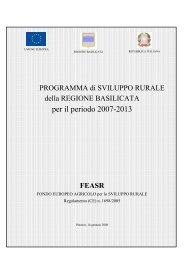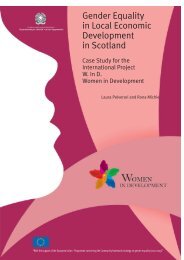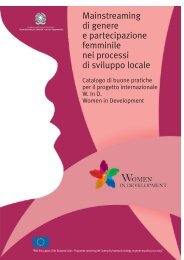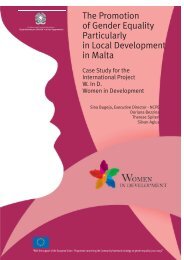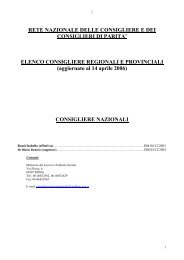<strong>The</strong> socio-economic contextinvolved the female component and ischaracterized by growth in the number <strong>of</strong> highlevelpr<strong>of</strong>essionals, as shown by the increase inthe number <strong>of</strong> women in entrepreneurial roles andthe more highly qualified independent pr<strong>of</strong>essions,as opposed to a net reduction <strong>of</strong> autonomoustraditional activities, <strong>of</strong> the manual typeand <strong>of</strong> a low pr<strong>of</strong>essional level.Despite the interruption <strong>of</strong> the time-series by theintroduction <strong>of</strong> new methods for surveying labourforces, the trends appear to be confirmed,although between 2004 and 2005 a reduction inthe number <strong>of</strong> female entrepreneurs was recorded,as well as an overall reduction in independentfemale labour.TABLE 2Employed women by position in the pr<strong>of</strong>ession - Average (in thousands )Positions in the pr<strong>of</strong>ession 1993 2003 Var. % 2.004 2.005 Var. %1993-2003 2004-2005Entrepreneurs 50 140 180,0% 82 73 -11,2%Pr<strong>of</strong>essionals 120 288 140,0% 301 305 1,3%Self-employed workers 906 775 -14,5% 931 905 -2,8%Associates in a cooperative 43 72 67,4% 23 17 -23,9%Assisting family member 596 486 -18,5% 325 250 -23,1%TOTALE 1.715 1.761 2,7% 1.662 1.550 -6,7%Source: Data processing by ISTAT<strong>The</strong> change is more extensive and deeper that theavailable Istat data on the labour forces outlines,especially for the fact that the work- and not onlyindependent work- comprises an ever lesshomogenous group that is in constant transformation.Although the autonomous job is not onthe increase, autonomy <strong>within</strong> the job isincreasing: with a general rise in educational levelsand skills comes a widespread pr<strong>of</strong>essionalautonomy among workers.<strong>The</strong> increase in women who lead an enterprise ormanage an independent activity is a relevant andwidespread phenomenon that regards manycountries, even in less-developed areas <strong>of</strong> theworld.In Italy too, female entrepreneurial activity hasseen a visible increase in the last decades. <strong>The</strong>primarily used source for studying theentrepreneurial phenomenon is the databaseMovimprese managed by InfoCamere.<strong>The</strong> most recent data produced by the sourcerefers to enterprises enrolled in the Registry <strong>of</strong>Companies in the Chamber <strong>of</strong> Commerce in 2006 4 .<strong>The</strong> comparison between the Istat survey data onthe labour forces and those emerging from theChamber <strong>of</strong> Commerce enrolment- despitedifficulties in comparing information on supplyand demand- suggests some elements on theconsistency and nature <strong>of</strong> the phenomenon,beginning with the different meaning that we cangive to the entrepreneurial role, even leaving asidethe specific definitions used by the varioussources 5 .4 Press Release March 5 20075 An important step forward in the availability <strong>of</strong> more reliable data on enterprises led by women was completed with the creation <strong>of</strong> the Observatory on female entrepreneurship,promoted by Unioncamere at the end <strong>of</strong> 2002. <strong>The</strong> Observatory selected as “female enterprise” those in which the participation <strong>of</strong> women is greater than 50%. <strong>The</strong> femaleparticipation rate is deduced, according to the legal form, from the proportion <strong>of</strong> female owners <strong>of</strong> enterprises or capital shares, or that have the role <strong>of</strong> administrator. <strong>The</strong>female presence is divided into three levels: majority (more than 50% <strong>of</strong> associates or administrators), strong (more than 60%), exclusive (100% <strong>of</strong> associates or administratorsor owners <strong>of</strong> enterprises as for individual companies).13
<strong>The</strong> promotion <strong>of</strong> gender equality <strong>within</strong> local development processes: ItalyTABLE 3Active enterprises and female enterprises by region and geographical area on December 31 2006 - Absolute values and variations %2006-2005Active enterprises Balance <strong>of</strong> 2006 Var. % 2006-2005Region Total female % Total Female Total Femaleenterprises female enterprises enterprises enterprisestotal 2006NORTH-WEST 1.374.610 305.798 22,25% 13428 3936 0,99% 1,30%NORTH-EAST 1.091.809 229.207 20,99% 5.760 2.062 0,53% 0,91%CENTRAL 969.562 243.503 25,11% 11.950 3.986 1,25% 1,66%SOUTH AND ISLANDS 1.722.297 456.411 26,50% 8.642 5.823 0,50% 1,29%ITALY 5.158.278 1.234.919 23,94% 39.780 15.807 0,78% 1,30%Source: Retecamere processing on Observatory <strong>of</strong> female entrepreneurship, Unioncamere-InfoCamere<strong>The</strong> main data from the Observatory makes itpossible to create a more precise pr<strong>of</strong>ile <strong>of</strong> femaleenterprises, while little can be gleaned about thefemale entrepreneurs because the only genderinformation from this source refers to “positions.”According to more recent data (December 31,2006), the female enterprises in Italy number1,234,919 (15,807 more than in 2005), growing ata more consistent pace than the total <strong>of</strong> theenterprises (+1.30% the percentage variation2006-2005 against the +0.78% <strong>of</strong> the total). <strong>The</strong>incidence <strong>of</strong> female enterprises on the total <strong>of</strong>enterprises reaches the value <strong>of</strong> 23.94% in 2006.<strong>The</strong> average data always conceals territorialdifferences that cannot be ignored and in somecases are even unexpected: in fact, the highestincidence <strong>of</strong> female enterprises is in the south <strong>of</strong>Italy, with more than 26% <strong>of</strong> the total, while in theNortheast these do not reach 21%.<strong>The</strong>se initial statistics already supply a few cluesregarding the characteristics <strong>of</strong> the enterprisesled by women, more widespread in productiveareas where companies are, on the average, smalland concentrated in the more traditional sectors(Agriculture, trade), while there are fewer in themore heavily industrialized areas where small tomedium sized enterprises are more common.Confirmation on the legal nature <strong>of</strong> femaleenterprise is confirmed by the data: almost 70.9%are individual companies (66.6% altogether),therefore for the most part concentrated in theexclusive form, that is with a total coincidencebetween the enterprise and a female figurerunning it.Nonstock corporations too, appear to be morewidespread among enterprises led by women(19.6%, against the average <strong>of</strong> 17.5%), inasmuchas in their turn, they are a simple form <strong>of</strong> business,adapted to the practice <strong>of</strong> commercial activitiesor small-scale productive activities.Overall, 92% <strong>of</strong> the female enterprises are part <strong>of</strong>these two legal types, while capital corporationsmake up 8.2%, against the average <strong>of</strong> 13.8%.<strong>Gender</strong> pay gapA last analytical element related to women’spresence in the labour market is due to salaryconditions (gender pay gap).14



